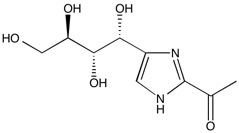THI | Immunomodulator
NMR (Conforms)

Available Options
| Size : | Price | Quantity | |
|---|---|---|---|
| 5 mg | $70.00 | ||
| 25 mg | $280.00 |
THI (94944-70-4) was identified as a biologically active impurity in caramel food coloring.1 It is a potent inhibitor of sphingosine-1-phosphate (S1P) lyase.2 It disrupts lymphocyte egress from lymphoid tissue by interfering with S1P gradients.3,4 The novel immunomodulatory activity of THI and its biochemical mechanism may represent a new target for the development of new generation of immunosuppressants.5
References/Citations:
1) MacKenzie et al. (1992), Toxicity Studies of Caramel Colour III and 2-Acetyl-4(5)-Tetrahydroxybutylimidazole in F344 rats; Food Chem. Toxicol. 30 417
2) Ohtoyo et al. (2015), Sphingosine 1-phosphate lyase inhibition by 2-acetyl-4-(tetrahydroxybutyl)imidazole (THI) under conditions of vitamin B6 deficiency; Mol.Cell Biochem. 400 125
3) Gugasyan et al. (1998), Emigration of mature T cells from the thymus is inhibited by the imidazole-based compound 2-acetyl-4-tetrahydroxybutylimidazole; Immunology 93 398
4) Schwab et al. (2005), Lymphocyte sequestration through S1P lyase inhibition and disruption of S1P gradients; Science 309 1735
5) Bradbury et al. (1997), The immunomodulatory compound 2-acetyl-4-tetrahydroxybutyl imidazole causes sequestration of lymphocytes in non-lymphoid tissue; Immunol. Cell Biol. 75 497
NMR (Conforms)
Safety Data Sheet:
Product Data Sheet:
Materials provided by Focus Biomolecules are for laboratory research use only and are not intended for human or veterinary applications. Please note that we do not sell to individuals and that all orders placed by non-research organizations will incur a $20 restocking/refund fee
THI (94944-70-4) was identified as a biologically active impurity in caramel food coloring.1 It is a potent inhibitor of sphingosine-1-phosphate (S1P) lyase.2 It disrupts lymphocyte egress from lymphoid tissue by interfering with S1P gradients.3,4 The novel immunomodulatory activity of THI and its biochemical mechanism may represent a new target for the development of new generation of immunosuppressants.5
References/Citations:
1) MacKenzie et al. (1992), Toxicity Studies of Caramel Colour III and 2-Acetyl-4(5)-Tetrahydroxybutylimidazole in F344 rats; Food Chem. Toxicol. 30 417
2) Ohtoyo et al. (2015), Sphingosine 1-phosphate lyase inhibition by 2-acetyl-4-(tetrahydroxybutyl)imidazole (THI) under conditions of vitamin B6 deficiency; Mol.Cell Biochem. 400 125
3) Gugasyan et al. (1998), Emigration of mature T cells from the thymus is inhibited by the imidazole-based compound 2-acetyl-4-tetrahydroxybutylimidazole; Immunology 93 398
4) Schwab et al. (2005), Lymphocyte sequestration through S1P lyase inhibition and disruption of S1P gradients; Science 309 1735
5) Bradbury et al. (1997), The immunomodulatory compound 2-acetyl-4-tetrahydroxybutyl imidazole causes sequestration of lymphocytes in non-lymphoid tissue; Immunol. Cell Biol. 75 497
Calculate the molar concentration, mass or volume in a solution.
Concentration × Volume × Molecular Weight = Mass
Focus Biomolecules • Plymouth Meeting, PA USA • 1-855-FOCUS21
Focus Biomolecules
Plymouth Meeting, PA USA
1-855-FOCUS21
Website Created by Advanta Advertising LLC.

